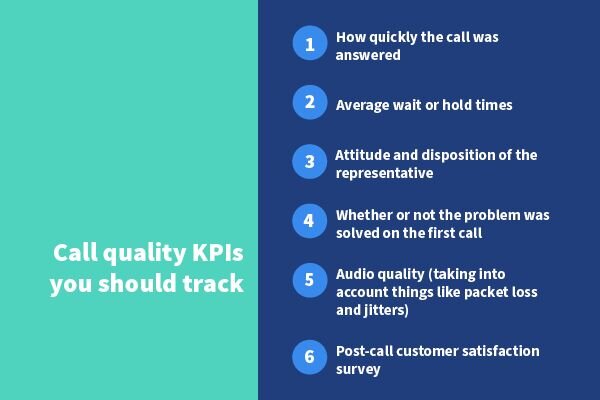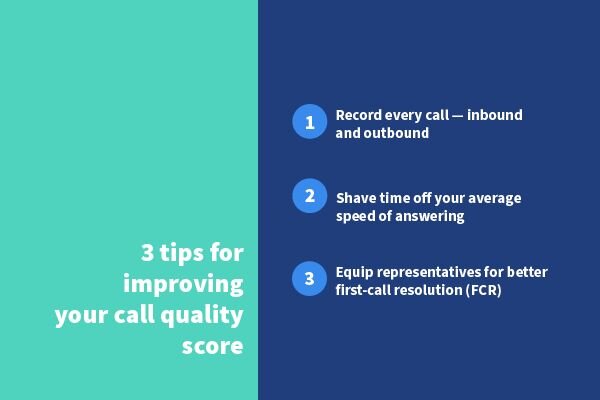“This call may be recorded for quality assurance and training purposes.”
If you’ve spent any time on the phone with customer service departments, then you’ve heard this recording before the call begins. It’s become so commonplace that most consumers don’t give it a second thought.
But how does a business use these recordings to measure quality assurance? What key performance indicators (KPIs) do they use to determine call quality? And can higher call quality scores actually contribute to a business’s bottom line?
The reality is, in today’s crowded marketplace, customer service and satisfaction can make or break a business. The business that focuses on measuring and improving their call quality score will find it easier to satisfy clients, stand out from their competition, and even find new customers.
What is a call quality score?

Call quality scores are measured by recording and analyzing customer service calls in order to determine the effectiveness and performance of call agents, call centers, and service departments. Higher call quality scores typically indicate better customer experiences, while lower call quality scores indicate poorer customer experiences.
Many factors contribute to an overall quality score, and some businesses will measure different KPIs depending on their industry or agent expectations. However, some common KPIs are
- How quickly the call was answered
- Average wait or hold times
- Attitude and disposition of the representative
- Whether or not the problem was solved on the first call
- Audio quality (taking into account things like packet loss and jitters)
- Post-call customer satisfaction surveys
Each of these factors is typically graded on a scale of 1-5 or 1-10 and recorded on a predetermined quality assurance scorecard. The resulting rankings provide a clear picture of agent performance and, combined with the customer satisfaction survey, give management and executive teams a clearer picture of how well their service department performs.
The importance of having a good quality score
More than ever, individuals are looking for quality customer service experience, especially when it comes to their interactions with you on the phone. Your call quality score plays a large part in client churn rate and lifetime value, which ultimately impacts your business’s revenue.
But how often have you been on the receiving end of a poor customer service experience on the phone? The ones where you’ve been left waiting for what feels like hours on end, only to receive no real help at all? It turns out businesses have a long way to go when it comes to improving call quality and customer service.
Here are some troubling statistics:
- 75% of customers said that it took too long to reach a live agent on the phone (TalkDesk)
- 50% of customers said that customer service failed to answer their question or provide a solution to their problem on the first call (TalkDesk)
- 78% of customers reported having backed out of a transaction or purchase because of a poor customer service experience (TalkDesk)
- Roughly 50% of customers said they would switch brands after a poor customer service experience (Zendesk)
What’s even more troubling: Americans, on average, tell only nine people about good customer service compared to the 16 people they tell about poor customer service. That means for every one negative experience someone has with your business, you negatively impact the chance of gaining 16 new clients.
The takeaway here is simple: Your business can’t afford to limp along with low-quality customer service, and how your business engages with customers on the phone now impacts your business not only today but also in the future.
So how can you improve your call quality score to make sure your customers are receiving the best experience possible when interacting with you over the phone? Here are three basic tips you can take today.
Tips for monitoring and improving your call quality score

Record every call — inbound and outbound
Call recording software provides multiple benefits that go beyond simply remembering what was said in each conversation. It also allows you to
- Conduct quality assurance checks by listening in on conversations between call agents and customers
- Gain insight into common questions and problems your customers are facing with your products or services
- Understand which marketing channels drive traffic
- Create training material for new hires.
Additionally, Conversation Intelligence software can automatically identify and flag specific keywords spoken by agents and/or customers, allowing you to quickly identify positive or negative phone calls without having to spend hours poring over transcripts and recordings.
Shave time off your average speed of answering
No matter how enjoyable the background music, no one likes being put on hold while waiting to talk to a customer service representative. Your business’s average speed of answering (ASA) plays a critical role in your call quality score.
To calculate ASA, measure the total wait time your customers experienced in a set period, and then divide that number by the total number of phone calls received in that time frame.
For example, if the total wait time all your customers experienced in a 24-hour period was 60 minutes, and you received 15 phone calls in that same time frame, your ASA would be four minutes (60 divided by 15 equals 4).
While it might be tempting to encourage customer service representatives to rush through phone calls to cut down on hold times, it’s just as important to provide high-quality service on each and every phone call. The best way to improve ASA isn’t to speed up phone calls; it’s to make sure your service reps are well equipped and trained to quickly and efficiently handle callers’ needs.
Also, be sure to analyze call agent workflows in order to find any bottlenecks that keep customers on hold longer than necessary. Time spent between calls, jotting down notes, or gathering information from customers, for example, can quickly add unwanted time to your ASA.
Equip representatives for better first-call resolution (FCR)
The first-call resolution (FCR) KPI measures the percentage of calls adequately answered and resolved the first time customers call. This metric is especially important considering that 38% of customers who don’t have their call resolved the first time around are likely to take their business elsewhere.
To improve your FCR, provide the training and resources agents need to quickly and efficiently answer questions and provide solutions to problems. Use the call recordings and transcripts you’ve gathered to hone in on frequently asked questions your customer service reps receive, then ensure every rep has easy access to these FAQs to provide quick responses and solutions to your customers.
Related: 10 Best Practices to Improve Your First Call Resolution
High call quality scores translate into exceptional customer service
Call quality assurance should be more than just a formality thrown in at the beginning of every call; it should be the backbone of your product or service offering. With increasing demand on businesses to provide exceptional customer service, taking steps to improve your call quality will pay dividends now and in the future.







